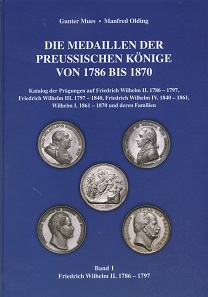by Ursula Kampmann
translated by Almuth Klingner
April 26, 2018 – It is not Manfred Olding’s first book on Prussian numismatics. In 1987, he published “Die Münzen Friedrichs des Großen” [The Coins of Frederick the Great], a book which, revised and extended, was published in second edition in 2006. “Die Medaillen auf Friedrich den Großen von Preußen” [The Medals on Frederick the Great of Prussia] followed in 2003, which was part of a deal Manfred Olding had made years earlier with two collectors: Dr. Günther Brockmann would catalog the coins up until 1740, which he did in 1994. Manfred Olding himself would take on Frederick the Great’s medals, while Gunter Mues was supposed to cover to period from 1786 until 1870. Unfortunately, Gunter Mues passed away before finishing his project. So, Manfred Olding filled in and, based on Mues’ extensive groundwork, has now published the catalog of the medals of Frederick William II. This is only the first volume, dealing with the era before the foundation of the German Empire. The catalogs for the successive kings – knowing Manfred Olding – will be published soon.
Gunter Mues, Manfred Olding, Die Medaillen der preußischen Könige von 1786 bis 1870. Katalog der Prägungen auf Friedrich Wilhelm II. 1786-1797, Friedrich Wilhelm III. 1797-1840, Friedrich Wilhelm IV. 1840-1861, Wilhelm I. 1861-1870 und deren Familien. Band 1: Friedrich Wilhelm II. 1786-1797. Die Medaillen der Kurfürsten und Könige von Brandenburg-Preußen Bd. 3. Battenberg Gietl Verlag, Regenstauf 2018. 116 S. all illustrations in color. 21,8 x 30,2 cm. Hardcover. ISBN: 978-3-86646-161-1. 69 euros.
In fact, the book does not need to be described in detail. If you have the Medals of Frederick of Prussia at home, you can imagine what you will find in the newest volume. Preceding the catalog are aids for its usage and an extensive index of the medalists and die cutters, including biographical data.
What is also quite useful is the compilation of German translations of all the Latin keys. And thus, we have already reached the catalog itself.
It includes both the official medal issues commissioned by the dynasty, and the unofficial, privately produced items meant for sale. The theme is not just the King himself but the entire royal family.
The medals are sorted by character and then chronologically. For every person honored on the medals, there is a short biography. Every number – this numbering applying to the entire volume, so logically not restarted for every member of the dynasty – is preceded by the minting year, occasion and responsible artist. What follows are mostly excellent photographs which make it easy to identify the item. Keys and descriptions, diameter and weight complete the cataloging. It is followed by a compilation of the collections where the respective item has been found, separately listed by material. The historical explanations were penned by Gunter Mues.
The volume is completed by a bibliography as well as an index of the collections and auction catalogs that were assessed. Very useful for handling the book is the key index, which helps to quickly find the right number, even when you are not that experienced in identifying Latin dates.
Is there anything else to say? Oh yes, the catalog is the new standard reference for the medals of Frederick William II. And since these are not that rare, it is worthwhile for coin dealers to buy it for their library. Collectors with an interest in this era should not wait for too long. After all, Olding’s catalog on the Prussian coins was out of print for several years, and the same may very well happen to this book.
You can order this book either at Battenberg or directly at the author.





